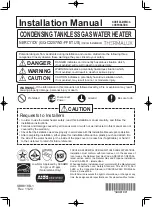
22
6. Install the system circulator as shown in the piping details in this section. Make sure the circulator is
properly sized for the system and friction loss.
7. Install an expansion tank on the system supply. Consult the expansion tank manufacturer’s instructions
for specific information related to expansion for the required system volume and capacity.
8. Install an air elimination device on the system supply.
9. Install a drain valve at the lowest point of system to blow out the system if needed. NOTE: The
hydronic heating module cannot be drained completely of water without purging the unit with an air
pressure greater than 15 psi but not exceeding 40 psi. If winterizing the unit it is recommended, use glycol
on the closed loop hydronic side only.
10. The relief valve is installed at the factory. A pipe discharge line should be installed to release 6” above
a drain, so discharge will be visible when pressure is relieved. The pipe size must be the same size as
the relief valve outlet.
Never block the outlet of the safety relief valve.
E. HYDRONIC HEATING MODULE OUTPUT
Hydronic heating module output is based on the burner input and the flow rate supplied by the selected
system circulator through the closed loop side of the brazed plate exchanger. Included in this section are
graphs that will help you size the appropriate circulator and output needed to meet your system design
requirements. Below is an example on the steps needed to determine the correct circulator for the
system.
Example: System design requires 120,000 Btu at 20 Delta
Step 1
Using the graphs, select the input rate of the heater. In this example, we would have to select a minimum
input of 199K (the 130K max. output is 100,000 Btu, which falls below our operating point).
Step 2
Next, go to the chart for the 199K burner input and select the point of operation where the Btu and Delta T
line intersect. Mark the point on the chart and go to bottom of the chart to determine flow rate needed to
achieve the rated output from the module. This example is 12 GPM.
Step 3
Select the correct circulator to meet the flow and resistance requirements for the system design. To
calculate this, you must determine the flow and resistance through the system and heating module. The
heating module requires 12 GPM at 10 feet of head. The system requires 12 GPM at 5 feet of head. To
select a circulator, add the resistance 10 feet of head (module) + 5 feet of head (system) at 12 GPM. This
system requires a circulator that operates at a resistance of 15 feet at 12 GPM (See examples in Figure
5, Figure 6, and Figure 7).
Summary of Contents for Versa Hydro PHE130-119
Page 23: ...23 Figure 5 Figure 6 ...
Page 24: ...24 Figure 7 ...
Page 25: ...25 F HYDRONIC PIPING Figure 8 ...
Page 26: ...26 Figure 9 ...
Page 27: ...27 Figure 10 ...
Page 28: ...28 Figure 11 ...
Page 29: ...29 Figure 12 ...
Page 32: ...32 F INTERNAL WIRING Figure 14 Internal connection diagram ...
Page 38: ...38 Figure 17 ...
Page 48: ...48 Figure 25 ...
Page 76: ...76 Figure 29 ...
Page 77: ...77 Figure 30 ...
Page 78: ...78 Figure 31 LP 314 G ...
Page 79: ...79 Figure 32 ...
Page 81: ...81 ...
Page 82: ...82 ...
Page 83: ...83 MAINTENANCE NOTES ...
















































